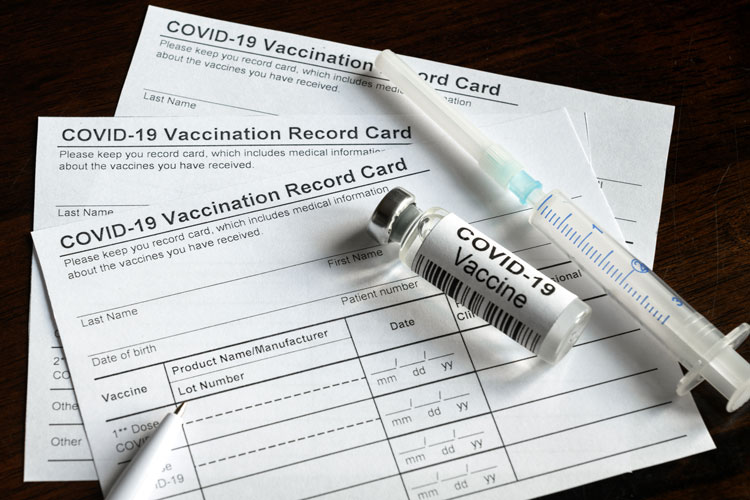Blog
The Federal OSHA Vaccinate or Test ETS is UN-enforceable…For Now. But the CMS Vaccination Mandate Moves Forward in All States.
This blog post can also be found on our Coronavirus Resource Center.
On January 25th, Federal OSHA announced that starting on January 26th the Federal OSHA COVID-19 ETS will be withdrawn and efforts to implement a permanent standard will be focused on. The CMS mandate for vaccination at all healthcare provider locations that receive Medicare or Medicaid funding will still be enforced by the CMS in all states.

So what does this mean for employers?
The CMS ruling means that healthcare employers in, Alabama, Alaska, Arizona, Arkansas, Georgia, Idaho, Indiana, Iowa, Kansas, Kentucky, Louisiana, Mississippi, Missouri, Montana, Nebraska, New Hampshire, North Dakota, Ohio, Oklahoma, South Carolina, South Dakota, Texas, Utah, West Virginia, and Wyoming, who were formerly shielded from enforcement by an injunction will now have to move forward with general compliance and mandatory vaccinations for employees, if they have not already. Employer guidance for compliance can be found here.
The 100 employee or more ETS is not enforceable, at least for now, but that does not mean that employers do not have to provide safety measures and continue to follow local mandates and regulations. States with state OSHA plans will not experience any change from this ruling except where their state plan adjusts their efforts accordingly. The 6th circuit court could still decide to allow the measure to move forward after hearing arguments. See a clip from the written ruling below that outlines this piece. It is noteworthy to mention that should the 6th circuit court not remove the stay and allow the measure to move forward, a similar ETS cannot be attempted by Federal OSHA and they must go through normal rule making processes to address COVID. In previous updates we mentioned that Federal OSHA started the ETS process simultaneously with a process of obtaining comment for a permanent rule making effort. That means that OSHA will likely continue to promulgate a permanent standard via the normal rule making process while the 6th circuit continues to hear arguments. That process does take time but also allows for input from stakeholders as it is promulgated, unlike the ETS. In the interim, Federal OSHA still has the general duty clause and all of the other regulations which existed prior to the ETS effort at their disposal.
From the Supreme Court written opinion:
OSHA’s COVID–19 Vaccination and Testing; Emergency Temporary Standard, 86 Fed. Reg. 61402, is stayed pending disposition of the applicants’ petitions for review in the United States Court of Appeals for the Sixth Circuit and disposition of the applicants’ petitions for writs of certiorari, if such writs are timely sought. Should the petitions for writs of certiorari be denied, this order shall terminate automatically. In the event the petitions for writs of certiorari are granted, the order shall terminate upon the sending down of the judgment of this Court.
Highlights of the OSHA ETS Wording that is Being Used as the Basis for a Permanent Standard Promulgation
A full summary of the 490-page register document is well beyond the scope of this regulatory update; we’ve provided some key highlights below, along with resources for your use in researching its requirements OSHA has provided a summary, a fact sheet, an FAQ, a link to the regulation outline, and several other useful items for review. The longer document (linked above) does provide some additional information on detailed items which may be relevant to your specific situation.
From a 20,000-foot view this ETS requires employers to either have all employees on site vaccinated or follow testing and masking protocols for those who are not vaccinated. Either way, a written plan is required. Whether secondary to accommodations from Title VII or the ADA or the employer chooses to offer the testing option, if unvaccinated employees are on site the testing and masking protocols must be followed. There is more to this topic and the accommodation process can affect masking and testing as well, so take a look at question set 3 in the FAQ for additional scenarios and details.
This regulation would likely not apply to those employers under some other regulations. That said, it is possible to have some employees under separate regulations. Questions 2.G – 2.K in the FAQ address some of these in more detail and will help you decide which regulation your employees fall under.
The original proposed wording was written in a way that extends what might be considered “benefits” to those who are vaccinated. That would include not having to test and not having to wear a mask. This is clearly not allowed by some jurisdictions so the proposed wording and local regulations may clash on this front. The local, more restrictive regulation prevails here.
The 100-employee threshold is defined and outlined in several scenarios, making it clear that the intent is a companywide count of employees at any point in time. If an employer hits the threshold even once, even for a day, during that time they must comply.
Employees provided by a temporary company belong to the temporary company and fall under the temporary company’s count only. Multi-employer worksites are not considered all together but rather each employer maintains their own employee count. Part-time employees count toward your number. This is a true headcount, not a full-time employee (FTE) count. The FAQ provided on the OSHA ETS page outlines this in detail in a shorter format than the full document. See questions 2.A.1 – 2.K.
If an employer meets the threshold there are still some employees who may not meet the requirements to follow the proposed wording protections. Some of those requirements include workers who work exclusively outdoors and workers who do not report to the workplace and do not have contact with the public or customers as part of their work duties (exclusively work-from-home employees should qualify). These categories are defined in the standard and outlined in the FAQ in question set 2.
As you review the FAQ, summary, or other on the OSHA ETS page you will note that employees who do not have to follow the the proposed wording still count toward the 100 employee threshold.
Written Policy and Vaccines
If you already have a written policy, what should you do?
This question is addressed in question 3.C. of the FAQ. You may need to add some things to your policy, or you may choose to take advantage of one of the two sample policies on the ETS page under the implementation title. If you hit the threshold, you will need a written policy and as of 11/5/21 you have 30 days to complete it.
The proposed wording requires the development of a roster tracking the vaccination status of all employees in the company whether fully vaccinated, partially vaccinated, or unvaccinated. This roster is a medical record per this standard and must be protected just as other medical records. The same is true for testing records. The ETS does provide access to certain records (the employees’ own) to an employee or their representative or an aggregate number for comparison (no names) for the entire number of vaccinated employees vs. total employees on site. See question 4.D Also see questions 11.A and 11.B as they address information timeframe requests, which run from next business day for employees to as little as four hours if records are requested by OSHA.
Section 1910.1020 outlines an employment plus 30-year retention for records of this type. The proposed wording specifically allows for vaccination records and testing records to be disposed of after the ETS is no longer in effect. To find this reference, go to the register document and search the word “retention.”
The proposed wording requires employers to pay up to four hours of time for each initial vaccination dose (does not address boosters). See question set 5 for details around how this can and cannot be done as well as for an explanation of what OSHA considers a reasonable amount of sick leave time (and where that time can come from) for recovery from side effects.
Vaccine Side Effects
In general, for side effects an employer can require the employee to use sick time, but if they do not have sick leave available the employer cannot cause them to run into negative sick leave time to recover from side effects. A full review of this section is likely needed to fully understand when employers can require the use of leave time to be used.
COVID-19 Testing
Testing can be done in several ways but one way in which it cannot be done is probably the most important part of this section. “….An over-the-counter (OTC) antigen test may not be both self-administered and self-read unless observed by the employer or an authorized telehealth proctor.” This requirement takes a self-test and attestation approach out of play. The test type, confirmation and which test is considered the most accurate, as well as other details are outlined in question set 6 in the FAQ.
Payment for testing is not defined in the proposed wording, meaning that employees could be made to arrange and pay for their own tests if there is not a local law stating otherwise. The long document states this was done to encourage employees to get vaccinated. Many employers foresee a loss of employees if they utilize this route so have already chosen to provide the testing for employees using third parties or in-house testing options. The proposed wording leaves this decision in the hands of the employer.
Protective Measures
Other topics not addressed by the proposed wording include exclusion pay, barriers, handwashing, and other protective measures currently used by employers and written into some local plans and requirements. As with other regulations, this one does not preclude local regulations which are more stringent than the proposed regulation itself. If you would like more information on these topics, go to question 7.D in the FAQ and in the main document, search the word "ventilation."
As of the morning of 11/5/21, the actual regulation outline was posted on the OSHA website under 1910.501.
This standard does have training and information requirements with it. Question set 9 in the FAQ addresses multiple training requirements, including information specific to the employers’ written policy elements, a CDC document on vaccine efficacy, anti-discrimination provisions around reporting from 1904.35 (English and Spanish fact sheets found at link within question 9A), and penalties for providing false information to OSHA from the OSH Act (English and Spanish fact sheets found at link within question 9A).
If you have questions around proposed Federal OSHA COVID-19 regulation, please contact your Woodruff Sawyer service team.
Author
Table of Contents













